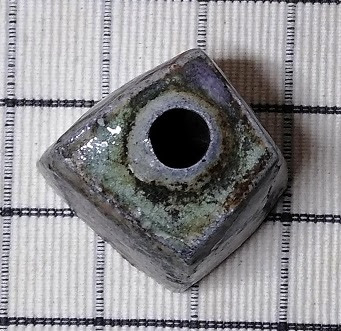206. Andrew Sartorius, Firebox Sculpture 21, “Triumvirate 2”
For Sartorius, see item 143.
This was the first in a series of three small sculptures.
West Virginia wild clay, wood-fired, then reglazed with a Shino glaze and refired in a cone 11 soda firing. Colors range from a grayish blue through mahoganies. Weight: 282 g (10 oz). Height: 6.3 cm (2-1/2 in). Dimensions: base 5.3 x 6 x 7 x 5.7 cm (2-1/8 x 2-3/8 x 2-3/4 x 2-1/4 in); top 3.8 x 5.7 x 5.1 x 4.4 cm (1-1/2 x 2-1/4 x 2 x 1-3/4 in).
This sits on a flat base. Remnants of the four posts used to keep this from fusing to the kiln surface are visible on the bottom. Each side is a quadrilateral; except at the base, where the walls meet the base in sharp line, the edges are slightly rounded. The line where the edges meet also bow outward slightly. The top slopes downward slightly viewed from the front (arbitrarily the view shown in the first picture). The opening is located in the upper portion of the top. The surface of this is smooth and glossy. The artist’s mark was impressed into the clay in the lower left-hand corner of one side. The subsequent firings and glazing obscured it somewhat (see the fourth picture).
This was wood-fired in the back of anagama kiln and naturally glazed over a four-day period with fine ash particles. It was then reglazed with a “very thin” coating of a Shino glaze and refired in a cone 11 soda firing, leaving the surface with a smooth shiny glaze and imparting a variety of colors in the blue and cream range. The colors are quite mottled and dynamic.
Multo in parvo
Purchased from the artist in January 2023.








































